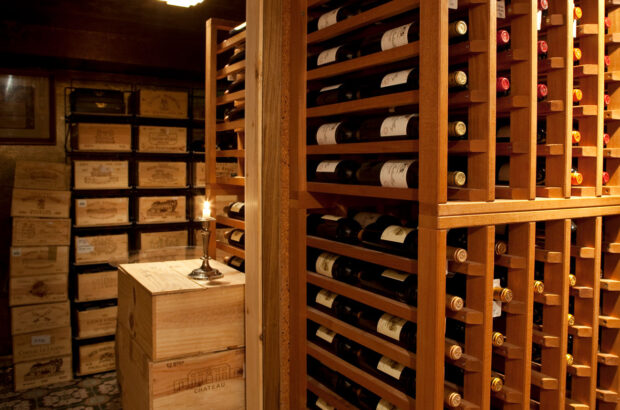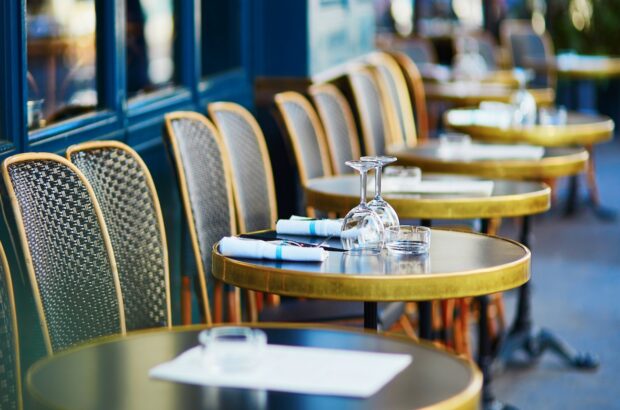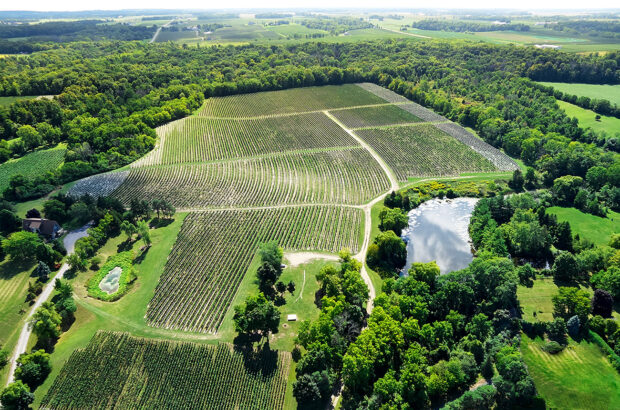The general saying that the southern Beaujolais growing area is limestone soil and the 10 crus to the north are on granitic soils is, in reality, too simplistic.
A comprehensive soil survey has confirmed local vignerons’ knowledge of the diverse terroirs found in Beaujolais, giving fuel for cru applications to INAO as well as to UNESCO.
Growers have long recognised the pockets of prime land that produce exceptional quality Gamay, declaring these as lieux-dits on their labels in order to communicate the characteristic wines they produce. Some of these lieux-dits are widely known and sought out, such as Côte du Py in Morgon, La Madone in Fleurie, and Champ de Cour in Moulin-à-Vent. Many more were identified over 100 years ago, even before the creation of the 10 Beaujolais crus themselves.
Scroll down for 10 expressive Beaujolais wines to seek out
{"content":"PC9wPgo8aDM+PHN0cm9uZz5UaGUgYmlnIGRpZzwvc3Ryb25nPjwvaDM+CjxwPkJldHdlZW4gMjAwOSBhbmQgMjAxOCwgSW50ZXIgQmVhdWpvbGFpcyBjb2xsYWJvcmF0ZWQgd2l0aCB0aGUgUmjDtG5lIENoYW1iZXIgb2YgQWdyaWN1bHR1cmUgb24gYSBkZXRhaWxlZCBpbnZlc3RpZ2F0aW9uIGludG8gdGhlIHNvaWxzIG9mIHRoZSBCZWF1am9sYWlzIHdpbmUgZ3Jvd2luZyByZWdpb24sIGNvbmR1Y3RlZCBieSBsZWFkaW5nIHNvaWwgc3R1ZHkgb2ZmaWNlIFNpZ2FsZXMuIFRoaXMgcmVzdWx0ZWQgaW4gYSBwcmVjaXNlIHNvaWwgbWFwIG9mIHRoZSBCZWF1am9sYWlzIGFyZWEuPC9wPgo8cD48ZGl2IGNsYXNzPSJhZC1jb250YWluZXIgYWQtY29udGFpbmVyLS1tb2JpbGUiPjxkaXYgaWQ9InBvc3QtaW5saW5lLTIiIGNsYXNzPSJpcGMtYWR2ZXJ0Ij48L2Rpdj48L2Rpdj48L3A+CjxwPlRoZSBleHBsb3JhdGlvbiBpbmNsdWRlZCBvdmVyIDE1LDAwMCBhdWdlciBzdXJ2ZXlzICh3aGljaCBpbnZvbHZlcyBkcmlsbGluZyBjeWxpbmRyaWNhbCBob2xlcyBpbnRvIHRoZSBncm91bmQpIHRvIGNvbGxlY3Qgc29pbCBzYW1wbGVzIHdlbGwgYmVsb3cgdGhlIHN1cmZhY2UsIGFzIHdlbGwgYXMgZGlnZ2luZyBvdmVyIDEsMDAwIHNvaWwgcGl0cyB1cCB0byB0d28gbWV0cmVzIGRlZXAuIEZhciBiZXlvbmQgbGltZXN0b25lIGFuZCBncmFuaXRlLCBvdmVyIDMwMCBzb2lsIHR5cGVzIHdlcmUgZGlzY292ZXJlZCBhbmQgZG9jdW1lbnRlZCwgcmV2ZWFsaW5nIGEgYmVhdXRpZnVsbHkgY29tcGxleCBnZW9sb2dpY2FsIHBpY3R1cmUuPC9wPgo8ZGl2IGlkPSJhdHRhY2htZW50XzQ5MTY4MyIgc3R5bGU9IndpZHRoOiA2NDBweCIgY2xhc3M9IndwLWNhcHRpb24gYWxpZ25jZW50ZXIiPjxpbWcgZmV0Y2hwcmlvcml0eT0iaGlnaCIgZGVjb2Rpbmc9ImFzeW5jIiBhcmlhLWRlc2NyaWJlZGJ5PSJjYXB0aW9uLWF0dGFjaG1lbnQtNDkxNjgzIiBjbGFzcz0ibGF6eWxvYWQgYmx1ci11cCBzaXplLWxhcmdlIHdwLWltYWdlLTQ5MTY4MyIgZGF0YS1wcm9jZXNzZWQgc3JjPSJodHRwczovL3d3dy5kZWNhbnRlci5jb20vd3AtY29udGVudC90aGVtZXMvc2ltYmEtdGhlbWUvYXNzZXRzL2ltYWdlcy9wbGFjZWhvbGRlci5wbmciIGRhdGEtc3JjPSJodHRwczovL2tleWFzc2V0cy50aW1laW5jdWsubmV0L2luc3BpcmV3cC9saXZlL3dwLWNvbnRlbnQvdXBsb2Fkcy9zaXRlcy8zNC8yMDIyLzExLzUweDcwLUNhcnRlLWRlcy1Tb2xzLWVuLTI1LWNsYXNzZXMtQnJvdWlsbHktQW5nbGFpcy1Db3B5LTYzMHg0MTcuanBnIiBhbHQ9IiIgd2lkdGg9IjYzMCIgaGVpZ2h0PSI0MTciIGRhdGEtc2l6ZXM9ImF1dG8iIGRhdGEtc3Jjc2V0PSJodHRwczovL2tleWFzc2V0cy50aW1laW5jdWsubmV0L2luc3BpcmV3cC9saXZlL3dwLWNvbnRlbnQvdXBsb2Fkcy9zaXRlcy8zNC8yMDIyLzExLzUweDcwLUNhcnRlLWRlcy1Tb2xzLWVuLTI1LWNsYXNzZXMtQnJvdWlsbHktQW5nbGFpcy1Db3B5LTYzMHg0MTcuanBnIDYzMHcsIGh0dHBzOi8va2V5YXNzZXRzLnRpbWVpbmN1ay5uZXQvaW5zcGlyZXdwL2xpdmUvd3AtY29udGVudC91cGxvYWRzL3NpdGVzLzM0LzIwMjIvMTEvNTB4NzAtQ2FydGUtZGVzLVNvbHMtZW4tMjUtY2xhc3Nlcy1Ccm91aWxseS1BbmdsYWlzLUNvcHktMzAweDE5OC5qcGcgMzAwdywgaHR0cHM6Ly9rZXlhc3NldHMudGltZWluY3VrLm5ldC9pbnNwaXJld3AvbGl2ZS93cC1jb250ZW50L3VwbG9hZHMvc2l0ZXMvMzQvMjAyMi8xMS81MHg3MC1DYXJ0ZS1kZXMtU29scy1lbi0yNS1jbGFzc2VzLUJyb3VpbGx5LUFuZ2xhaXMtQ29weS0xMzV4ODkuanBnIDEzNXcsIGh0dHBzOi8va2V5YXNzZXRzLnRpbWVpbmN1ay5uZXQvaW5zcGlyZXdwL2xpdmUvd3AtY29udGVudC91cGxvYWRzL3NpdGVzLzM0LzIwMjIvMTEvNTB4NzAtQ2FydGUtZGVzLVNvbHMtZW4tMjUtY2xhc3Nlcy1Ccm91aWxseS1BbmdsYWlzLUNvcHktMzIweDIxMi5qcGcgMzIwdywgaHR0cHM6Ly9rZXlhc3NldHMudGltZWluY3VrLm5ldC9pbnNwaXJld3AvbGl2ZS93cC1jb250ZW50L3VwbG9hZHMvc2l0ZXMvMzQvMjAyMi8xMS81MHg3MC1DYXJ0ZS1kZXMtU29scy1lbi0yNS1jbGFzc2VzLUJyb3VpbGx5LUFuZ2xhaXMtQ29weS02MjB4NDEwLmpwZyA2MjB3LCBodHRwczovL2tleWFzc2V0cy50aW1laW5jdWsubmV0L2luc3BpcmV3cC9saXZlL3dwLWNvbnRlbnQvdXBsb2Fkcy9zaXRlcy8zNC8yMDIyLzExLzUweDcwLUNhcnRlLWRlcy1Tb2xzLWVuLTI1LWNsYXNzZXMtQnJvdWlsbHktQW5nbGFpcy1Db3B5LTkyMHg2MDkuanBnIDkyMHcsIGh0dHBzOi8va2V5YXNzZXRzLnRpbWVpbmN1ay5uZXQvaW5zcGlyZXdwL2xpdmUvd3AtY29udGVudC91cGxvYWRzL3NpdGVzLzM0LzIwMjIvMTEvNTB4NzAtQ2FydGUtZGVzLVNvbHMtZW4tMjUtY2xhc3Nlcy1Ccm91aWxseS1BbmdsYWlzLUNvcHktMTIyMHg4MDcuanBnIDEyMjB3LCBodHRwczovL2tleWFzc2V0cy50aW1laW5jdWsubmV0L2luc3BpcmV3cC9saXZlL3dwLWNvbnRlbnQvdXBsb2Fkcy9zaXRlcy8zNC8yMDIyLzExLzUweDcwLUNhcnRlLWRlcy1Tb2xzLWVuLTI1LWNsYXNzZXMtQnJvdWlsbHktQW5nbGFpcy1Db3B5LmpwZyAxMzAwdyIgc2l6ZXM9IihtYXgtd2lkdGg6IDYzMHB4KSAxMDB2dywgNjMwcHgiIC8+PHAgaWQ9ImNhcHRpb24tYXR0YWNobWVudC00OTE2ODMiIGNsYXNzPSJ3cC1jYXB0aW9uLXRleHQiPlRoZSBwcmVjaXNlIG1hcHMgcmV2ZWFsIHRoZSBkaWZmZXJlbnQgdHlwZXMgb2Ygc29pbCB3aXRoaW4gZWFjaCBjcnUuIENyZWRpdDogSW50ZXIgQmVhdWpvbGFpcy48L3A+PC9kaXY+CjxwPlRoZSByZWdpb27igJlzIHNvaWwgaGlzdG9yeSBkYXRlcyBiYWNrIG92ZXIgNTAwIG1pbGxpb24geWVhcnMsIGFuZCB0aGUgcmVhc29uIHRoZSBldmlkZW5jZSBzdGlsbCBleGlzdHMgaW4gdGhlIHZpbmV5YXJkcyBpcyBiZWNhdXNlIEJlYXVqb2xhaXMgd2FzIHNwYXJlZCBkdXJpbmcgdGhlIGdsYWNpYWwgcGVyaW9kOyBpdHMgb2xkIHJvY2tzIGFuZCBzYW5keSBzb2lscyB3ZXJlIG5vdCB3YXNoZWQgYXdheSBieSBtZWx0aW5nIGdsYWNpZXJzLjwvcD4KPGRpdiBjbGFzcz0iYWQtY29udGFpbmVyIGFkLWNvbnRhaW5lci0tbW9iaWxlIj48ZGl2IGlkPSJwb3N0LWlubGluZS0zIiBjbGFzcz0iaXBjLWFkdmVydCI+PC9kaXY+PC9kaXY+Cjxocj4KPGRpdiBjbGFzcz0iYnJlYWtvdXQgcGFsZXR0ZS1hIHBhbmVsIHBhbmVsLWRlZmF1bHQiPjxkaXYgY2xhc3M9InBhbmVsLWJvZHkiPjxkaXYgY2xhc3M9J2JyZWFrb3V0LWNvbnRlbnQnPjwvcD4KPGgzPjxzdHJvbmc+QSBicmllZiBnZW9sb2dpY2FsIGhpc3Rvcnkgb2YgQmVhdWpvbGFpczwvc3Ryb25nPjwvaDM+CjxwPlRoZSBEZXZvbmlhbiBlcmEgKDQwMCBtaWxsaW9uIHllYXJzIGFnbykgd2FzIGFuIGVyYSBvZiB1bmRlcndhdGVyIHZvbGNhbmljIGVydXB0aW9ucyBhbmQgZGV2ZWxvcG1lbnQgb2Ygb2NlYW4gbGlmZSwgcmVzdWx0aW5nIGluIHRoZSBjcmVhdGlvbiBvZiBibHVlIHN0b25lcyAocGllcnJlcyBibGV1ZXMpLiBUaGVzZSBhcmUgZm91bmQgdGhyb3VnaG91dCBKdWxpw6luYXMsIHRoZSBDw7R0ZSBkdSBQeSBsaWV1LWRpdCBpbiBNb3Jnb24sIGFuZCBDw7R0ZSBkZSBCcm91aWxseS48L3A+CjxkaXYgY2xhc3M9ImFkLWNvbnRhaW5lciBhZC1jb250YWluZXItLW1vYmlsZSI+CjxkaXYgaWQ9InBvc3QtaW5saW5lLTQiIGNsYXNzPSJpcGMtYWR2ZXJ0Ij48L2Rpdj4KPC9kaXY+CjxwPkJyb3VpbGx5ICh0aGUgYXJlYSBzdXJyb3VuZGluZyB0aGUgTW9udCBCcm91aWxseSkgaXMgdGhlIGxhcmdlc3Qgb2YgdGhlIGNydXMgd2l0aCB0aGUgbW9zdCBkaXZlcnNlIHNlbGVjdGlvbiBvZiBzb2lsIHR5cGVzOiBncmFuaXRlcywgYmx1ZSBzdG9uZXMsIHNjcmVlIGFuZCBsaW1lc3RvbmUgc2VkaW1lbnRzLjwvcD4KPHA+SW4gdGhlIENhcmJvbmlmZXJvdXMgcGVyaW9kICgzMjAgbWlsbGlvbiB5ZWFycyBhZ28pIOKAkyB3aGVuIHRoZSBjb250aW5lbnRzIGNvbGxpZGVkIHRvZ2V0aGVyIGZvcm1pbmcgUGFuZ2VhIOKAkyBncmFuaXRlIHdhcyBmb3JtZWQsIHByb2R1Y2luZyB0aGUgZmFtb3VzIHBpbmsgZ3Jhbml0ZSBvZiBDaGlyb3VibGVzIGFuZCBGbGV1cmllLjwvcD4KPGRpdiBjbGFzcz0iYWQtY29udGFpbmVyIGFkLWNvbnRhaW5lci0tbW9iaWxlIj4KPGRpdiBpZD0icG9zdC1pbmxpbmUtNSIgY2xhc3M9ImlwYy1hZHZlcnQiPjwvZGl2Pgo8L2Rpdj4KPHA+VGhlIFRyaWFzc2ljIHBlcmlvZCAoMjQwIG1pbGxpb24geWVhcnMgYWdvKSB3YXMgdGhlIHRyYW5zaXRpb24gcG9pbnQgYmV0d2VlbiBhbmNpZW50IGJlZHJvY2sgYW5kIHRoZSBtb3JlIHJlY2VudCBzZWRpbWVudGFyeSBhbmQgbGltZXN0b25lIHNvaWxzLiBUaGlzIHBlcmlvZCBjb250cmlidXRlZCBxdWFydHogYW5kIHNhbmRzdG9uZSwgYXMgd2VsbCBhcyBjbGF5IGFuZCBtYXJsIGZyb20gc2VhIGRlcG9zaXRzLiBUaGUgZGl2ZXJzZSBjb21iaW5hdGlvbiBvZiBjYWxjYXJlb3VzLCBncmFuaXRlIGFuZCBhbGx1dmlhbCBzb2lscyBmb3VuZCBpbiBNb3VsaW4tw6AtVmVudCBhbmQgU2FpbnQtQW1vdXIgZGF0ZSBiYWNrIHRvIHRoaXMgcGVyaW9kLjwvcD4KPHA+CjwvZGl2PjxkaXYgY2xhc3M9J2JyZWFrb3V0LWJ1dHRvbnMnPjxkaXYgY2xhc3M9J3Jvdyc+PC9kaXY+PC9kaXY+PC9kaXY+PC9kaXY+Cjxocj4KPGgzPjxzdHJvbmc+UmVhY2hpbmcgZm9yIHByZW1pZXIgY3J1IHN0YXR1czwvc3Ryb25nPjwvaDM+CjxwPkhhdmluZyB1bmNvdmVyZWQgd2hhdCBnZW5lcmF0aW9ucyBvZiBwcm9kdWNlcnMgbG9uZyBzdXNwZWN0ZWQsIHRoZSBzb2lsIHN0dWR5IGdhdmUgdGhlIHNjaWVudGlmaWMgYmFja2luZyB0b3dhcmRzIGFuIGFwcGxpY2F0aW9uIHRvIFVORVNDTy4gSW4gQXByaWwgMjAxOCBCZWF1am9sYWlzIHdhcyByZWNvZ25pc2VkIGFzIGEgVU5FU0NPIEdsb2JhbCBHZW9wYXJrIOKAkyBvbmUgb2YgdGhlIGZpcnN0IEZyZW5jaCB3aW5lIHJlZ2lvbnMgdG8gZ2FpbiB0aGlzIHN0YXR1cy48L3A+CjxwPlVORVNDTyBHbG9iYWwgR2VvcGFya3MgYXJlIGFyZWFzIG9mIG91dHN0YW5kaW5nIGdlb2xvZ2ljYWwgaGVyaXRhZ2UsIGludGVybmF0aW9uYWxseSByZWNvZ25pc2VkIGFuZCBtYW5hZ2VkIHdpdGggYSBob2xpc3RpYyBjb25jZXB0IG9mIHByb3RlY3Rpb24sIGVkdWNhdGlvbiBhbmQgc3VzdGFpbmFibGUgZGV2ZWxvcG1lbnQuIFRoZXJlIDE3NyBhcm91bmQgdGhlIGdsb2JlIGFjcm9zcyA0NiBjb3VudHJpZXMuIEluIEZyYW5jZSwgb3RoZXIgd2luZSByZWdpb25zIHdpdGggR2VvcGFyayBzdGF0dXMgaW5jbHVkZSB0aGUgTW9udHMgZOKAmUFyZMOoY2hlIChjb3ZlcmluZyB0aGUgSUdQIEFyZMOoY2hlKSwgTHViZXJvbiBhbmQgSGF1dGUtUHJvdmVuY2UuPC9wPgo8cD5BZGRpdGlvbmFsbHksIHRoZSBzb2lsIHN0dWR5IG1vdGl2YXRlZCBzZXZlcmFsIG9mIEJlYXVqb2xhaXPigJkgQUNzIHRvIGNvb3BlcmF0ZSBpbiBhcHBseWluZyBmb3IgcHJlbWllciBjcnUgc3RhdHVzIGZvciB0aGVpciBtb3N0IHByb21pc2luZyBsaWV1eC1kaXRzLjwvcD4KPHA+R3LDqWdvaXJlIEhvcHBlbm90LCBzZWNyZXRhcnkgb2YgdGhlIEZsZXVyaWUgYXBwZWxsYXRpb24sIHNheXMg4oCYV2UgYXJlIHF1aXRlIHJlYWR5IG5vdy4gV2UganVzdCBuZWVkIHRvIGFncmVlIG9uIHRoZSBmaW5hbCBsaXN0IG9mIHByZW1pZXJzIGNydXMgdG8gcHJlc2VudCB0byB0aGUgSU5BTywgd2Ugd2lsbCBsaWtlbHkgc3VibWl0IGJ5IE1hcmNoIDIwMjMu4oCZPC9wPgo8cD7igJhJdOKAmXMgYSBiaWcgaW52ZXN0bWVudCBmb3IgdXMs4oCZIGFkbWl0cyBIb3BwZW5vdC4g4oCYV2Ugc3RhcnRlZCB0aGUgd29yayBmb3VyIHllYXJzIGFnbyBmb2xsb3dpbmcgdGhlIHNvaWwgc3R1ZHkgYW5kIGluIHRoZSBiZXN0LWNhc2Ugc2NlbmFyaW8gaXQgd291bGQgYmUgYXBwcm92ZWQgaW4gMTAgeWVhcnMu4oCZPC9wPgo8cD5UaGUgbGlzdCBvZiBwcmVtaWVycyBjcnVzIHRoZXkgd2lsbCBwcm9wb3NlIHJlcHJlc2VudHMgMjAlLTMwJSBvZiB0aGUgRmxldXJpZSBhcHBlbGxhdGlvbiwgaW5jbHVkaW5nIHNvbWUgb2YgdGhlIG1vc3QgcmVjb2duaXNlZCBsaWV1eC1kaXRzIGluIEZsZXVyaWUuIOKAmFdlIGFyZSBwcm9wb3NpbmcgdG8gZWxldmF0ZSBbdG8gcHJlbWllciBjcnUgbGV2ZWxdIHRoZSBsaWV1eC1kaXRzIHRoYXQgYXJlIHRoZSBtb3N0IGZyZXF1ZW50bHkgZGVjbGFyZWQgW29uIGxhYmVsc10sIHRoZSBtb3N0IHByZXNlbnQgaW4gdGhlIHByZXNzIGFuZCBpbiBoaXN0b3JpY2FsIGJvb2tzLCB0aGUgbW9zdCBleHBlbnNpdmUsIGFuZCB0aGUgbW9zdCBpbnRlcmVzdGluZyB3ZSB0YXN0ZWQu4oCZPC9wPgo8ZGl2IGlkPSJhdHRhY2htZW50XzQ5MTY4NSIgc3R5bGU9IndpZHRoOiA2NDBweCIgY2xhc3M9IndwLWNhcHRpb24gYWxpZ25jZW50ZXIiPjxpbWcgZGVjb2Rpbmc9ImFzeW5jIiBhcmlhLWRlc2NyaWJlZGJ5PSJjYXB0aW9uLWF0dGFjaG1lbnQtNDkxNjg1IiBjbGFzcz0ibGF6eWxvYWQgYmx1ci11cCBzaXplLWxhcmdlIHdwLWltYWdlLTQ5MTY4NSIgZGF0YS1wcm9jZXNzZWQgc3JjPSJodHRwczovL3d3dy5kZWNhbnRlci5jb20vd3AtY29udGVudC90aGVtZXMvc2ltYmEtdGhlbWUvYXNzZXRzL2ltYWdlcy9wbGFjZWhvbGRlci5wbmciIGRhdGEtc3JjPSJodHRwczovL2tleWFzc2V0cy50aW1laW5jdWsubmV0L2luc3BpcmV3cC9saXZlL3dwLWNvbnRlbnQvdXBsb2Fkcy9zaXRlcy8zNC8yMDIyLzExLzA1OV9ldGllbm5lX3JhbW91c3NlX2ludGVyLWJlYXVqb2xhaXNfdmVuZGFuZ2VzXzIwMThfaGRfZXh0ZXJuZV8yMDE4LTU5LTYzMHg0MTcuanBnIiBhbHQ9IiIgd2lkdGg9IjYzMCIgaGVpZ2h0PSI0MTciIGRhdGEtc2l6ZXM9ImF1dG8iIGRhdGEtc3Jjc2V0PSJodHRwczovL2tleWFzc2V0cy50aW1laW5jdWsubmV0L2luc3BpcmV3cC9saXZlL3dwLWNvbnRlbnQvdXBsb2Fkcy9zaXRlcy8zNC8yMDIyLzExLzA1OV9ldGllbm5lX3JhbW91c3NlX2ludGVyLWJlYXVqb2xhaXNfdmVuZGFuZ2VzXzIwMThfaGRfZXh0ZXJuZV8yMDE4LTU5LTYzMHg0MTcuanBnIDYzMHcsIGh0dHBzOi8va2V5YXNzZXRzLnRpbWVpbmN1ay5uZXQvaW5zcGlyZXdwL2xpdmUvd3AtY29udGVudC91cGxvYWRzL3NpdGVzLzM0LzIwMjIvMTEvMDU5X2V0aWVubmVfcmFtb3Vzc2VfaW50ZXItYmVhdWpvbGFpc192ZW5kYW5nZXNfMjAxOF9oZF9leHRlcm5lXzIwMTgtNTktMzAweDE5OC5qcGcgMzAwdywgaHR0cHM6Ly9rZXlhc3NldHMudGltZWluY3VrLm5ldC9pbnNwaXJld3AvbGl2ZS93cC1jb250ZW50L3VwbG9hZHMvc2l0ZXMvMzQvMjAyMi8xMS8wNTlfZXRpZW5uZV9yYW1vdXNzZV9pbnRlci1iZWF1am9sYWlzX3ZlbmRhbmdlc18yMDE4X2hkX2V4dGVybmVfMjAxOC01OS0xMzV4ODkuanBnIDEzNXcsIGh0dHBzOi8va2V5YXNzZXRzLnRpbWVpbmN1ay5uZXQvaW5zcGlyZXdwL2xpdmUvd3AtY29udGVudC91cGxvYWRzL3NpdGVzLzM0LzIwMjIvMTEvMDU5X2V0aWVubmVfcmFtb3Vzc2VfaW50ZXItYmVhdWpvbGFpc192ZW5kYW5nZXNfMjAxOF9oZF9leHRlcm5lXzIwMTgtNTktMzIweDIxMi5qcGcgMzIwdywgaHR0cHM6Ly9rZXlhc3NldHMudGltZWluY3VrLm5ldC9pbnNwaXJld3AvbGl2ZS93cC1jb250ZW50L3VwbG9hZHMvc2l0ZXMvMzQvMjAyMi8xMS8wNTlfZXRpZW5uZV9yYW1vdXNzZV9pbnRlci1iZWF1am9sYWlzX3ZlbmRhbmdlc18yMDE4X2hkX2V4dGVybmVfMjAxOC01OS02MjB4NDEwLmpwZyA2MjB3LCBodHRwczovL2tleWFzc2V0cy50aW1laW5jdWsubmV0L2luc3BpcmV3cC9saXZlL3dwLWNvbnRlbnQvdXBsb2Fkcy9zaXRlcy8zNC8yMDIyLzExLzA1OV9ldGllbm5lX3JhbW91c3NlX2ludGVyLWJlYXVqb2xhaXNfdmVuZGFuZ2VzXzIwMThfaGRfZXh0ZXJuZV8yMDE4LTU5LTkyMHg2MDkuanBnIDkyMHcsIGh0dHBzOi8va2V5YXNzZXRzLnRpbWVpbmN1ay5uZXQvaW5zcGlyZXdwL2xpdmUvd3AtY29udGVudC91cGxvYWRzL3NpdGVzLzM0LzIwMjIvMTEvMDU5X2V0aWVubmVfcmFtb3Vzc2VfaW50ZXItYmVhdWpvbGFpc192ZW5kYW5nZXNfMjAxOF9oZF9leHRlcm5lXzIwMTgtNTktMTIyMHg4MDcuanBnIDEyMjB3LCBodHRwczovL2tleWFzc2V0cy50aW1laW5jdWsubmV0L2luc3BpcmV3cC9saXZlL3dwLWNvbnRlbnQvdXBsb2Fkcy9zaXRlcy8zNC8yMDIyLzExLzA1OV9ldGllbm5lX3JhbW91c3NlX2ludGVyLWJlYXVqb2xhaXNfdmVuZGFuZ2VzXzIwMThfaGRfZXh0ZXJuZV8yMDE4LTU5LmpwZyAxMzAwdyIgc2l6ZXM9IihtYXgtd2lkdGg6IDYzMHB4KSAxMDB2dywgNjMwcHgiIC8+PHAgaWQ9ImNhcHRpb24tYXR0YWNobWVudC00OTE2ODUiIGNsYXNzPSJ3cC1jYXB0aW9uLXRleHQiPlRoZSBzb2lsIG1hcHBpbmcgaGFzIG5vdCBvbmx5IGNvbmZpcm1lZCB3aGF0IHByb2R1Y2VycyBoYXZlIHN1c3BlY3RlZCBmb3IgbWFueSB5ZWFycywgYnV0IGFsc28gaGVscGVkIHRoZW0gd2l0aCB2aW5leWFyZCBhbmQgcGxvdCBzZWxlY3Rpb24uIENyZWRpdDogRXRpZW5uZSBSYW1vdXNzZS48L3A+PC9kaXY+CjxwPkl0IHdvdWxkIGJlIGEgbWFqb3IgY291cCBmb3IgdGhlIHJlZ2lvbiB0byBnYWluIHByZW1pZXIgY3J1IHN0YXR1cywgYXMgaXQmIzgyMTc7cyB0aGUgb25seSBwYXJ0IG9mIHRoZSBCdXJndW5keSByZWdpb24gdGhhdCBkb2VzIG5vdCBhbHJlYWR5IGhhdmUgcHJlbWllciBvciBncmFuZCBjcnUgbGV2ZWwgdmluZXlhcmRzLiBHYWluaW5nIHByZW1pZXIgY3J1IHdpbGwgYWxsb3cgY2VydGFpbiBwcm9kdWNlcnMgdG8gY2hhcmdlIG1vcmUgZm9yIHRoZWlyIHdpbmVzIGFuZCBjb250aW51ZSB0byBidWlsZCB0aGVpciByZXB1dGF0aW9uIGZvciBxdWFsaXR5LiBUaGUgcmVnaW9uIGhhcyBhbHNvIGJlZW4gaW5zcGlyZWQgYnkgbmVpZ2hib3VyaW5nIE3DomNvbiBnYWluaW5nIHByZW1pZXIgY3J1IHZpbmV5YXJkcyBpbiByZWNlbnQgeWVhcnMuPC9wPgo8cD5Ib3dldmVyIG5vdCBhbGwgcHJvZHVjZXJzIGFyZSBvbiBib2FyZC4g4oCYVGhlcmUgd2lsbCBiZSBzb21lIHByb2R1Y2VycyB3aG8gdXNlIGEgbGlldS1kaXQgb24gdGhlaXIgbGFiZWwsIGJ1dCB0aGUgSU5BTyBtYXkgb25seSBhcHByb3ZlIHBhcnQgb2YgdGhlIHZpbmV5YXJkcyBpbiB0aGF0IGxpZXUtZGl0IHRvIGJlIG9mIHByZW1pZXIgY3J1IGxldmVsLiBJZiB5b3VyIHZpbmV5YXJkcyBhcmUgbm90IGluY2x1ZGVkLCB0aGVuIG9uY2UgdGhhdCBsaWV1LWRpdCBiZWNvbWVzIHByZW1pZXIgY3J1IHlvdSBjYW4gbm90IHVzZSBpdCBvbiB0aGUgbGFiZWwsIGV2ZW4gaWYgeW914oCZdmUgYmVlbiBkb2luZyBzbyBmb3IgZGVjYWRlcyzigJkgc2F5cyBIb3BwZW5vdC48L3A+CjxwPkZvciB0aGlzIHZlcnkgcmVhc29uLCBNb3Jnb24gaGFzIG5vdCBtYWRlIHByb2dyZXNzIHRvd2FyZHMgYSBwcmVtaWVyIGNydSBhcHBsaWNhdGlvbi4gVGhlIEPDtHRlIGR1IFB5IGlzIGEgdmVyeSBsYXJnZSBhbmQgZmFtb3VzIGxpZXUtZGl0IHRoYXQgbWFueSBwcm9kdWNlcnMgdXNlLCBidXQgb25seSBhIHBvcnRpb24gb2YgaXQgd291bGQgbGlrZWx5IGdhaW4gcHJlbWllciBjcnUgc3RhdHVzLCBhbmQgaXQgaXMgYSBuYW1lIG1vc3QgcHJvZHVjZXJzIGFyZSBub3Qgd2lsbGluZyB0byBsb3NlIGZyb20gdGhlaXIgbGFiZWxzLjwvcD4KPHA+QnJvdWlsbHkgYW5kIEPDtHRlIGRlIEJyb3VpbGx5IGFyZSBuZXh0IGluIGxpbmUgdG8gc3VibWl0IHRoZWlyIGFwcGxpY2F0aW9ucyB0byB0aGUgSU5BTyBlYXJseSBuZXh0IHllYXIuIEp1bGnDqW5hcyBhbmQgTW91bGluLcOgLVZlbnQgYXJlIG5vdCBmYXIgYmVoaW5kIGFzIHRoZXkgY29tcGlsZSB0aGUgbmVjZXNzYXJ5IGRvY3VtZW50YXRpb24gd2l0aGluIHRoZWlyIHJlc3BlY3RpdmUgcmVnaW9ucy48L3A+CjxwPuKAmFRoZSBwcmVtaWVyIGNydSB3aWxsIGhlbHAgY29uc3VtZXJzIGlkZW50aWZ5IHRoZSBiZXN0IHNpdGVzIGZyb20gb3VyIHJlZ2lvbiwgYnV0IGV2ZW4gd2l0aG91dCBpdCwgb3VyIHZpZ25lcm9ucyBoYXZlIGJlY29tZSB2ZXJ5IHByb3VkIGFuZCBlbnRodXNpYXN0aWMgYWJvdXQgdGhlIHNvaWxzIGFuZCBxdWFsaXR5IG9mIG91ciB3aW5lcyzigJkgc2F5cyBIb3BwZW5vdC48L3A+CjxkaXYgY2xhc3M9ImJyZWFrb3V0IHBhbGV0dGUtYSBwYW5lbCBwYW5lbC1kZWZhdWx0Ij48ZGl2IGNsYXNzPSJwYW5lbC1ib2R5Ij48ZGl2IGNsYXNzPSdicmVha291dC1jb250ZW50Jz48L3A+CjxwPjxzdHJvbmc+V2hhdCBkb2VzIGFwcGx5aW5nIGZvciBwcmVtaWVyIGNydSBzdGF0dXMgaW52b2x2ZT88L3N0cm9uZz48L3A+CjxwPjxlbT5HcsOpZ29pcmUgSG9wcGVub3QsIHNlY3JldGFyeSBmb3IgQUMgRmxldXJpZSwgcmV2ZWFscyB0aGUgcHJvY2Vzczo8L2VtPjwvcD4KPGRpdiBjbGFzcz0iaW5qZWN0aW9uIj48L2Rpdj4KPHA+MS4gPHN0cm9uZz5EZWNsYXJhdGlvbjwvc3Ryb25nPjogV2Ugb2JzZXJ2ZWQgdGhlIGhhcnZlc3QgZGVjbGFyYXRpb24gb3ZlciB0aGUgcGFzdCAxMCB5ZWFycyBhbmQgY291bnRlZCB0aGUgcGVyY2VudGFnZSBvZiBGbGV1cmll4oCZcyBncm93aW5nIGFyZWEgaWRlbnRpZmllZCBhcyBsaWV1eC1kaXRzLjxiciAvPgoyLiA8c3Ryb25nPkJpYmxpb2dyYXBoeTwvc3Ryb25nPjogV2UgcmVzZWFyY2hlZCwgdGhyb3VnaCBib29rcyB3cml0dGVuIGZyb20gMTc0NyB0byB0aGUgcHJlc2VudCBkYXksIGFueSBoaXN0b3JpY2FsIG1lbnRpb24gb2YgbGlldXgtZGl0cyBpbiB0aGUgcmVnaW9uLjxiciAvPgozLiA8c3Ryb25nPlJhdGluZ3M8L3N0cm9uZz46IFdlIGlkZW50aWZpZWQgdGhlIGxpZXV4LWRpdHMgd2l0aCB0aGUgaGlnaGVzdCByYXRpbmdzIGluIHRoZSBGcmVuY2ggYW5kIEJyaXRpc2ggcHJlc3MuPGJyIC8+CjQuIDxzdHJvbmc+VGFzdGluZ3M6IDwvc3Ryb25nPldlIHRhc3RlZCBtb3JlIHRoYW4gMTIwIHdpbmVzIGZyb20gMzIgZGlmZmVyZW50IGxpZXV4LWRpdHMgYmV0d2VlbiBKYW51YXJ5IDIwMjAgYW5kIEp1bmUgMjAyMi48YnIgLz4KNS4gPHN0cm9uZz5QcmljZTwvc3Ryb25nPjogV2UgY29tcGFyZWQgdGhlIHByaWNlcyBvZiB3aW5lcyBsYWJlbGxlZCB3aXRoIGEgbGlldS1kaXQgYWdhaW5zdCB3aW5lcyBsYWJlbGxlZCBhcyBnZW5lcmljIEZsZXVyaWUuPC9wPgo8cD4KPC9kaXY+PGRpdiBjbGFzcz0nYnJlYWtvdXQtYnV0dG9ucyc+PGRpdiBjbGFzcz0ncm93Jz48L2Rpdj48L2Rpdj48L2Rpdj48L2Rpdj4KPHA+Cg=="}
10 expressive Beaujolais wines to try:
{}
{"wineId":"63663","displayCase":"standard","paywall":true}
{"wineId":"63666","displayCase":"standard","paywall":true}
{"wineId":"63665","displayCase":"standard","paywall":true}
{"wineId":"63671","displayCase":"standard","paywall":true}
{"wineId":"63667","displayCase":"standard","paywall":true}
{"wineId":"63664","displayCase":"standard","paywall":true}
{"wineId":"63669","displayCase":"standard","paywall":true}
{"wineId":"63672","displayCase":"standard","paywall":true}
{"wineId":"63668","displayCase":"standard","paywall":true}
{"wineId":"63670","displayCase":"standard","paywall":true}
{}
Related content











